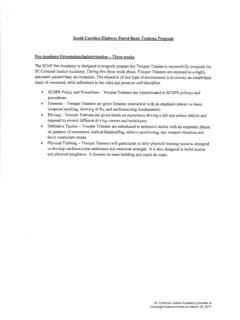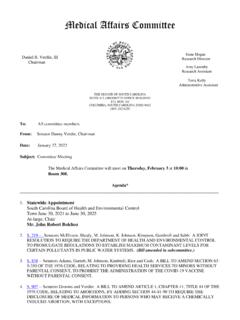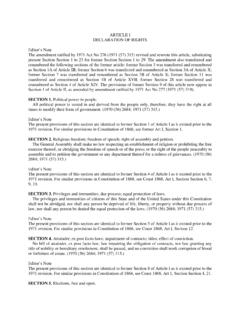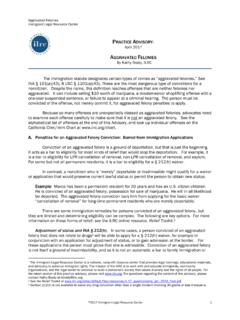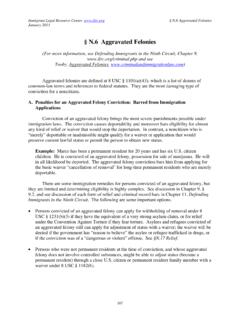Transcription of South Carolina’s Legislative Process
1 South Carolina sLegislative ProcessSouth Carolina sLegislative ProcessLPBkltCvr_2016_15th 12th edition 11/18/16 2:49 PM Page 1 THELEGISLATIVEPROCESSLPB ooklet_2016_15th 12th edition 11/18/16 3:00 PM Page 1 October 201615th EditionLPBooklet_2016_15th 12th edition 11/18/16 3:00 PM Page 2 THELEGISLATIVEPROCESSThe contents of this pamphlet consist ofSouth Carolina s Legislative Process , pub-lished by Charles F. Reid, Clerk of the SouthCarolina House of Representatives. Thematerial is reproduced with 12th edition 11/18/16 3:00 PM Page 3 LPBooklet_2016_15th 12th edition 11/18/16 3:00 PM Page 4 SouthCarolina sLegislativeProcessHISTORYTo understand the Legislative Process , it is nec-essary to know a few facts about the lawmak-ing body. The South Carolina Legislature consistsof two bodies the Senate and the House of Rep-resentatives. There are 170 members 46 Sena-tors and 124 Representatives representingdis tricts based on population. When these twobodies are referred to collectively, the Senate andHouse are together called the General be eligible to be a Representative, a personmust be at least 21 years old, and Senators mustbe at least 25 years old.
2 Members of the Houseserve for two years; Senators serve for four terms of office begin on the Monday followingthe General Election which is held in even num-bered years on the first Tuesday after the firstMonday in Constitution provides members immunityfrom arrest while attending and traveling to andfrom the General Assembly during the session andfor ten days before and ten days after is no immunity for a member charged withcertain criminal offenses: treason, felony or breachof the body can punish its members for disor-derly behavior if it sees fit to do so. If two-thirdsof the members agree, the body can expel a mem- ber from the session, but the body cannot expel thesame member a second time for the same of the House and Senate may meeton the first Tuesday following certification of theelection for a maximum of three days to organizational session includes: election of5 LPBooklet_2016_15th 12th edition 11/18/16 3:00 PM Page 5officers, appointment of standing committees,adoption of rules, assignment of desks, and otherhousekeeping presiding officer of the House is the Speaker,who is a member of the House elected by fellowHouse members for a two-year term.
3 Other officerselected are Speaker Pro Tempore, Clerk, Chaplain,Reading Clerk, and Lieutenant Governor is elected in a statewideelection and serves as President of the Senatealthough he is not a Senator. While presiding, hedoes not vote except where the vote is tied. TheSenate chooses a President Pro Temporeto act inthe absence of the Lieutenant Governor. OtherSenate officers are Clerk, Chaplain, Reading Clerk,and Legislature begins in regular session annu-ally in Columbia on the second Tuesday in Januaryand must adjourn sine dienot later than the sec-ond Thursday in May unless an extension is agreedto by a two-thirds vote of both bodies. Normally,the House and Senate meet in statewide sessionon Tuesday, Wednesday, and Thursday and forlocal matters on Friday. The Governor may call theGeneral Assembly into a special session if neces-sary, beyond the regular member of the House and Senate is paidan annual salary of $10, 12th edition 11/18/16 3:00 PM Page 6 HOWA BILLBECOMESA LAWB ills and Resolutions typically start in the Leg-islative Council, the department responsiblefor the organization and operation of research, ref-erence, and Bill drafting facilities.
4 A member tellsthe Legislative Council attor ney the type of Bill hewants to introduce, and it is put into legal the member reads and checks the legisla-tion, he gives it to the Clerk of his body. A Bill orJoint Resolution cannot become law until it hasbeen read three times on three separate days ineach body, has the Great Seal of the State put on it,and has been signed by the President of the Sen-ate and Speaker of the may be prefiled before the beginning of asession. Prefiled Bills are numbered, dated, andreferred to committee. A list of prefiled Bills is sentto the members. On the first day of the session, allprefiled Bills are officially introduced and put intothe record. If there are committee reports on anyof the Bills, they are also put into the received during the session are introducedand read the first time, given a number, andreferred to the proper committee. The Constitu-tion states that each Bill or Resolution shall relateto only one subject and the subject shall beexpressed in the title.
5 Some Bills are placed onthe Calendar (agenda) without being sent to 12th edition 11/18/16 3:00 PM Page 7 COMMITTEESThe work done by the General Assembly is dur-ing the formal Legislative session when itmeets three days a week. Many people do notrealize that committees do the majority of legisla-tive work and are the backbone of the legislativeprocess. Before any Bill is considered by eitherbody, many hours of work take place by the mem-bers of the standing committee to which the Billis assigned. The Legislature relies on its commit-tees to eliminate the less important measures andreport only those deserving the attention of theentire House or working through standing committees, eachbody may have each Bill considered by memberswho have specialized knowledge in the subject ofthe Bill. Many members have knowl edge of par-ticular subjects, and these members are usuallyassigned to committees in order to utilize theirspecific knowledge and experience. Because ofthis, the Legislature often accepts the recommen-dations of the standing committees.
6 This is not tosay that the General Assembly is not aware of itsresponsibility to consider all pending Bills. A greatdeal of work is also done by interim committees,or committees appointed to consider importantsubjects between the sessions of the are thirteen standing committees in theHouse. Each considers Bills about a specific sub-ject or area of legislation. The committees are:Agriculture, Natural Resources andEnvironmental Affairs (18 members)Education and Public Works (18 members)Interstate Cooperation (5 members)Invitations and Memorial Resolutions (5 members)Judiciary (25 members)Labor, Commerce and Industry (18 members) Legislative Ethics (10 members) Legislative Oversight (20 members)Medical, Military, Public and Municipal Affairs(18 members)Operations and Management advisory to theSpeaker about personnel, administration andmanagement (8 members)8 LPBooklet_2016_15th 12th edition 11/18/16 3:00 PM Page 8 Regulations and Administrative Procedures (13members)Rules (15 members)Ways and Means (25 members)There are 15 Senate standing committees.
7 Thecommittees are:Agriculture and Natural Resources (17 members)Banking and Insurance (17 members)Corrections and Penology (17 members)Education (17 members)Ethics (10 members)Finance (23 members)Fish, Game and Forestry (17 members)General Committee (17 members)Interstate Cooperation (5 members)Invitations (11 members)Judiciary (23 members)Labor, Commerce and Industry (17 members)Medical Affairs (17 members)Rules (17 members)Transportation (17 members)Standing committees examine Bills and recom-mend action on them. During the day when theLegislature is in session but not actually meeting,the committees will meet and work on the Billsreferred to cannot underestimate the importance ofthe research, study, and information gathering thatmust take place for any Bill. Research assistants inthe General Assembly gather and compile infor- mation for the members to study. As subjects andissues grow more complex, there is greater demandfor this research. The pub lic may never see this behind the scenes work, but there is a great dealof preparation done for every Bill before it reachesthe floor of the Senate or the a committee completes work on a Bill,it prepares a report detailing its recommenda-tions.
8 The report is then submitted to the respec-tive body in the daily session at the appropriatetime. The Bill, with the committee report, is put onthe Calendar for second reading and is taken up. ABill must be on the desks of the members at leastone day (when they are in session) before second9 LPBooklet_2016_15th 12th edition 11/18/16 3:00 PM Page 9reading. On most Bills, recommendations of thecommittee are followed, but either body mayoverrule the action of the committee. In order toprevent a committee from killing a Bill by notworking on it, either body may recall the Bill fromcommittee by a majority are listed on the Calendar by number,sponsors, and title in the order in which they areintroduced and reported by committees. They arethen considered for second reading. Some Bills,such as the State Appropriations Bill, are set forSpecial Order, which moves them to the top ofthe Calendar. A Bill on second reading may befully debated, amended, committed or recommit-ted, tabled, a Bill has been discussed, there is a voteon the Bill.
9 Voting may be by division, voice voteor roll call. Since there are more members in theHouse than the Senate, it would take a lot of timeto register individual votes by calling the of this, the House uses electronic votinginstead of calling each member s name. The Housemembers vote by pushing buttons on their are registered by lights on a board in thechamber. The board contains all the members names and how each member voted. Votes arerecorded and entered in the Journal. In the Senate,the Reading Clerk calls the Senators names inalphabetical order, and their votes are entered intothe third reading a Bill may be acted on asin second reading, except that it usually takesunanimous consent to amend it. After the amend-ments are written into the Bill, it is then signedby the Clerk and sent to the other body by mes-senger. Once sent to the other body, the Bill fol-lows practically the same route pursuant to thatbody s example, assume a Bill has been introducedin the House, debated, amended, adopted, andsent to the Senate.
10 If the Senate amends the HouseBill, it is returned to the House for House may agree or disagree with the Sen-ate amendment or make changes to the Senateamendment and return it to the Senate. Should10 LPBooklet_2016_15th 12th edition 11/18/16 3:00 PM Page 10the House disagree with the Senate amendment,a message is sent to the Senate. The Senate willeither insist upon or recede from their the Senate insists upon its amendment, amessage is sent to the House listing the names ofthree Senators appointed to a conference com-mittee. The Speaker of the House then appointsthree members of the House to a conference com-mittee. The six members meet and try to reachan agreement. If they agree, their report is sentto both bodies for adoption. When the report isadopted by both bodies, the Bill is orderedenrolled for ratification. Should the conferencecommittee not agree, they may return to theirrespective bodies and ask for free conferencepowers, which requires a two-thirds vote of eachbody.
